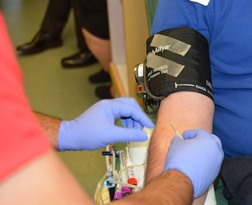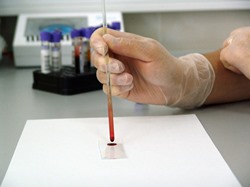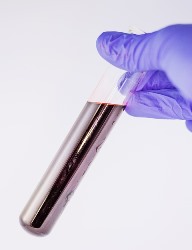Choosing a Phlebotomy School near Imperial Missouri
 Selecting the ideal phlebotomy technician training near Imperial MO is a critical first step toward a gratifying profession as a phlebotomist. It might seem like a difficult task to assess and compare each of the training alternatives that are available to you. Nevertheless it’s vital that you perform your due diligence to ensure that you obtain a superior education. In reality, many prospective students start their search by considering 2 of the qualifiers that first come to mind, which are location and cost. An additional option you might look into is whether to attend online classes or commute to a nearby campus. We’ll review a bit more about online classes later in this article. What’s important to keep in mind is that there is much more to checking out phlebotomy training programs than locating the closest or the cheapest one. Other variables such as accreditation and reputation are also significant considerations and need to be part of your selection process too. To assist in that effort, we will furnish a list of questions that you should ask each of the phlebotomy schools you are evaluating to help you choose the ideal one for you. But before we do that, let’s cover what a phlebotomist is and does, and afterwards continue our discussion about online training.
Selecting the ideal phlebotomy technician training near Imperial MO is a critical first step toward a gratifying profession as a phlebotomist. It might seem like a difficult task to assess and compare each of the training alternatives that are available to you. Nevertheless it’s vital that you perform your due diligence to ensure that you obtain a superior education. In reality, many prospective students start their search by considering 2 of the qualifiers that first come to mind, which are location and cost. An additional option you might look into is whether to attend online classes or commute to a nearby campus. We’ll review a bit more about online classes later in this article. What’s important to keep in mind is that there is much more to checking out phlebotomy training programs than locating the closest or the cheapest one. Other variables such as accreditation and reputation are also significant considerations and need to be part of your selection process too. To assist in that effort, we will furnish a list of questions that you should ask each of the phlebotomy schools you are evaluating to help you choose the ideal one for you. But before we do that, let’s cover what a phlebotomist is and does, and afterwards continue our discussion about online training.
[campusexplorer header_text=”Find Phlebotomy Schools Near You!” aos=”75346615″ concentration=”E7147EE5″ tracking=”PHL-CT”]
Phlebotomy Technician Work Description
 A phlebotomist, or phlebotomy technician, draws blood from patients. While that is their principal task, there is actually so much more to their job description. Before drawing a blood sample, a phlebotomist needs to verify that the tools being employed are single use only and sterile. Following the collection, the sample has to be accurately labeled with the patient’s information. Next, paperwork has to be correctly completed in order to track the sample from the point of collection through the lab testing procedure. The phlebotomist then delivers the blood to either an an outside lab facility or an in-house lab where it may be screened for such things as pregnancy, infectious diseases or blood type. A number of Imperial MO phlebotomists actually work in laboratories and are accountable for ensuring that samples are tested correctly utilizing the strictest quality assurance procedures. And if those weren’t sufficient responsibilities, they can be required to train other phlebotomists in the drawing, delivery and follow-up process.
A phlebotomist, or phlebotomy technician, draws blood from patients. While that is their principal task, there is actually so much more to their job description. Before drawing a blood sample, a phlebotomist needs to verify that the tools being employed are single use only and sterile. Following the collection, the sample has to be accurately labeled with the patient’s information. Next, paperwork has to be correctly completed in order to track the sample from the point of collection through the lab testing procedure. The phlebotomist then delivers the blood to either an an outside lab facility or an in-house lab where it may be screened for such things as pregnancy, infectious diseases or blood type. A number of Imperial MO phlebotomists actually work in laboratories and are accountable for ensuring that samples are tested correctly utilizing the strictest quality assurance procedures. And if those weren’t sufficient responsibilities, they can be required to train other phlebotomists in the drawing, delivery and follow-up process.
Where do Phlebotomy Techs Work?
The quickest answer is wherever there are patients. Their work environments are numerous and diverse, including Imperial MO hospitals, medical clinics, nursing homes, or blood banks. They may be tasked to draw blood samples from patients of all ages, from babies or young children to seniors. Some phlebotomists, depending on their training and their practice, specialize in collecting samples from a certain type of patient. For example, those practicing in a nursing home or assisted living facility would exclusively be collecting blood from older patients. If they are working in a maternity ward, they would be collecting blood from newborns and mothers solely. In contrast, phlebotomy technicians working in a general hospital environment would be collecting samples from a wide range of patients and would work with new patients each day.
Phlebotomy Training, Certification and Licensing
 There are essentially two kinds of programs that offer phlebotomist training in Imperial MO, which are certificate and degree programs. The certificate program usually takes less than a year to finish and furnishes a general education as well as the training on how to draw blood. It offers the quickest means to becoming a phlebotomy tech. An Associate of Science Degree in Clinical Laboratory Science, although not exclusively a phlebotomy degree, will include training to become a phlebotomy tech. Available at community and junior colleges, they usually take 2 years to complete. Bachelor’s Degrees are less accessible and as a 4 year program offer a more expansive background in lab sciences. Once you have completed your training, you will no doubt want to become certified. Although not mandated in most states, many employers require certification before employing technicians. A few of the primary certifying agencies include:
There are essentially two kinds of programs that offer phlebotomist training in Imperial MO, which are certificate and degree programs. The certificate program usually takes less than a year to finish and furnishes a general education as well as the training on how to draw blood. It offers the quickest means to becoming a phlebotomy tech. An Associate of Science Degree in Clinical Laboratory Science, although not exclusively a phlebotomy degree, will include training to become a phlebotomy tech. Available at community and junior colleges, they usually take 2 years to complete. Bachelor’s Degrees are less accessible and as a 4 year program offer a more expansive background in lab sciences. Once you have completed your training, you will no doubt want to become certified. Although not mandated in most states, many employers require certification before employing technicians. A few of the primary certifying agencies include:
- National Phlebotomy Association
- National Healthcareer Association (NHA)
- American Society for Clinical Pathology (ASCP)
- American Medical Technologists (AMT)
There are several states that do require certification prior to practicing as a phlebotomist, including California and Nevada. California and a few other states even require licensing. So it’s important that you select a phlebotomy training program that not only supplies a premium education, but also readies you for any certification or licensing exams that you are required or elect to take.
Online Phlebotomy Colleges
 First, let’s resolve one potential mistaken belief. You can’t obtain all of your phlebotomy training online. A substantial portion of the course of study will be practical training and it will be conducted either in an approved Imperial MO healthcare facility or an on-campus lab|an on-campus lab or an approved healthcare facility}. Numerous courses also require completing an internship in order to graduate. But since the non-clinical component of the training may be attended online, it could be a more practical option for some students. As an additional benefit, many online classes are less expensive than their on-campus competitors. And some costs, for instance those for commuting or textbooks, may be minimized also. Just verify that the online phlebotomy program you choose is accredited by a national or regional accrediting agency (more on accreditation later). With both the comprehensive online and clinical training, you can receive a premium education with this method of learning. If you are disciplined enough to study at home, then obtaining your degree or certificate online may be the right option for you.
First, let’s resolve one potential mistaken belief. You can’t obtain all of your phlebotomy training online. A substantial portion of the course of study will be practical training and it will be conducted either in an approved Imperial MO healthcare facility or an on-campus lab|an on-campus lab or an approved healthcare facility}. Numerous courses also require completing an internship in order to graduate. But since the non-clinical component of the training may be attended online, it could be a more practical option for some students. As an additional benefit, many online classes are less expensive than their on-campus competitors. And some costs, for instance those for commuting or textbooks, may be minimized also. Just verify that the online phlebotomy program you choose is accredited by a national or regional accrediting agency (more on accreditation later). With both the comprehensive online and clinical training, you can receive a premium education with this method of learning. If you are disciplined enough to study at home, then obtaining your degree or certificate online may be the right option for you.
Subjects to Ask Phlebotomy Colleges
Now that you have a general understanding about what it takes to become a phlebotomy tech, it’s time to initiate your due diligence process. You may have already picked the type of program you intend to enroll in, whether it be for a certificate or a degree. As we mentioned earlier, the location of the Missouri school is relevant as well as the tuition expense. Possibly you have opted to enroll in an online phlebotomy college. All of these decisions are a critical part of the process for choosing a program or school. But they are not the sole considerations when arriving at your decision. Following are some questions that you need to ask about each of the Imperial MO colleges you are considering prior to making your ultimate decision.
Is the Phlebotomy Program Specific to Your State? As previously mentioned, each state has its own laws for practicing as a phlebotomist. Several states call for certification, while a few others require licensing. Each has its own prerequisite regarding the minimum hours of practical training completed prior to practicing as a phlebotomy tech. As a result, you might have to pass a State Board, certification or licensing exam. Therefore it’s very important to enroll in a phlebotomist program that satisfies the state specific requirements for Missouri or the state where you will be practicing and preps you for any exams you may have to take.
Is the College Accredited? The phlebotomist school and program you select should be accredited by a reputable national or regional accrediting agency, such as the National Accrediting Agency for Clinical Laboratory Sciences (NAACLS). There are several benefits to graduating from an accredited program in addition to a guarantee of a quality education. First, if your program is not accredited, you will not be able to sit for a certification examination administered by any of the previously listed certifying agencies. Next, accreditation will help in securing loans or financial assistance, which are frequently not available for non-accredited schools in Imperial MO. Finally, earning a certificate or a degree from an accredited school can make you more desirable to future employers in the job market.
What is the Program’s Reputation? In many states there is little or no regulation of phlebotomy colleges, so there are those that are not of the highest caliber. So in addition to accreditation, it’s imperative to check the reputations of all colleges you are reviewing. You can begin by requesting references from the schools from employers where they place their graduates as part of their job assistance program. You can screen online school rating and review services and solicit the accrediting agencies for their reviews also. You can also contact several Imperial MO area clinics or hospitals that you might have an interest in working for and find out if they can provide any recommendations. As a final thought, you can check with the Missouri school licensing authority and find out if any complaints have been submitted or if the colleges are in full compliance.
Is Ample Training Included? To begin with, check with the Missouri regulator or the state regulator where you will be practicing to learn if there are any minimum requirements for the length of training, both clinical and classroom. At a minimum, any Imperial MO phlebotomist program that you are looking at should furnish at least 40 hours of classroom training (the majority require 120) and 120 hours of practical training. Anything below these minimums might signify that the program is not expansive enough to furnish sufficient training.
Are Internships Sponsored? Find out from the Missouri colleges you are reviewing if they have an internship program in partnership with regional health care facilities. They are the ideal means to obtain hands-on practical training often not obtainable on campus. As an added benefit, internships can help students develop relationships within the local Imperial MO health care community. And they look good on resumes also.
Is Job Placement Assistance Offered? Getting your first phlebotomy position will be a lot easier with the help of a job placement program. Ask if the schools you are looking at offer assistance and what their job placement rate is. If a school has a high rate, meaning they place the majority of their students in positions, it’s an indication that the college has both an excellent reputation together with a large network of professional contacts within the Imperial MO health care community.
Are Classes Compatible With Your Schedule? Finally, it’s critical to verify that the final college you choose provides classes at times that will accommodate your hectic schedule. This is particularly true if you decide to still work while attending school. If you need to attend classes in the evenings or on weekends near Imperial MO, check that they are available at those times. Also, if you can only attend on a part-time basis, confirm it is an option also. And if you have decided to attend online, with the clinical training requirement, make sure those hours can also be completed within your schedule. And find out what the make-up policy is should you have to miss any classes because of illness or emergencies.
Why Did You Desire to Be a Phlebotomy Tech?
When preparing to interview for a Phlebotomy Tech job, it's advantageous to review questions you could be asked. Among the questions that recruiters typically ask Phlebotomy Tech prospects is "What drove you to choose Phlebotomy as a career?". What the interviewer is trying to discover is not merely the personal reasons you may have for becoming Phlebotomist, but also what qualities and talents you possess that make you exceptional at what you do. You will undoubtedly be asked questions relating primarily to Phlebotomy, in addition to a significant number of standard interview questions, so you need to prepare a number of approaches about how you would like to answer them. Since there are numerous variables that go into choosing a career, you can answer this fundamental question in a variety of ways. When formulating an answer, aim to include the reasons the profession appeals to you in addition to the abilities you possess that make you an exceptional Phlebotomy Technician and the best candidate for the job. Don't try to memorize a response, but write down a few ideas and talking points that pertain to your own experiences and strengths. Reviewing sample answers can help you to prepare your own concepts, and provide ideas of what to include to wow the recruiter.Select the Right Phlebotomist School near Imperial MO
Making certain that you enroll in the right phlebotomy training is an essential first step toward your success in this rewarding medical care field. As we have discussed in this article, there are several factors that go into the selection of a quality program. Phlebotomist certificate or degree programs are available in a number of academic institutes, such as community or junior colleges, vocational schools, and colleges and universities that offer an extensive range of courses in medical care and health sciences. Program offerings can differ slightly from state to state as every state has its own criteria when it pertains to phlebotomy training, licensing and certification. The most critical point is that you must diligently screen and compare each school prior to making your final choice. By addressing the questions that we have furnished, you will be able to fine tune your options so that you can pick the best school for you. And with the proper training, you can accomplish your goal of becoming a phlebotomy technician in Imperial MO.
Learn About Imperial Missouri
Operation Mo
Operation Mo (MO作戦, Mo Sakusen) or the Port Moresby Operation was a Japanese plan to take control of the Australian Territory of New Guinea during World War II as well as other locations in the South Pacific with the goal of isolating Australia and New Zealand from their ally the United States. The plan was developed by the Imperial Japanese Navy and supported by Admiral Isoroku Yamamoto, the commander-in-chief of the Combined Fleet. The operation was ultimately abandoned.
When the Japanese Navy was planning the New Guinea Campaign (air strikes against Lae and Salamaua, disembarkation in Huon Gulf, New Britain (Rabaul), New Ireland (Kavieng), Finch Harbor (also called Finschhafen), and the capture of Morobe and Buna), strategists envisioned those territories as support points to implement the capture of Port Moresby. The implementation of these operations was assigned to the Japanese Naval task force led by Admiral Chūichi Nagumo, after completing the Java campaign. Another important step was the occupation of Christmas Island to the south of Java. The Japanese Navy General Staff had been considering Operation Mo since 1938, as a step in the consolidation of the Southern Seas areas in the Greater East Asia Co-Prosperity Sphere (大東亜共栄圏 Dai-tō-a Kyōeiken).[citation needed]
The Directive of Operation Mo was conceived in 1938, but with no specific time for its execution, pending earlier successes in the southern area during the first and second phases of the conquest.
In April 1942, the operation was organized into four large actions and was approved by the Army and Navy General Staffs:
More Interesting Missouri Cities
Business Results 1 - 5 of 24
Imperial MO Blood Labs - BingNews Search results
-
Charges filed in fatal shooting overnight in Imperial, Mo.
IMPERIAL, Mo. (First Alert 4) - An Arnold man has been charged with murder in a fatal shooting late Wednesday in Imperial. Jefferson County prosecutors on Thursday charged Chaptur Wagoner ...




